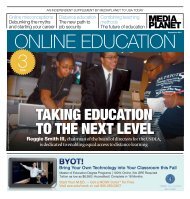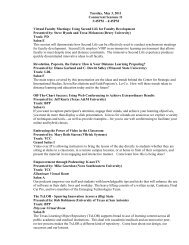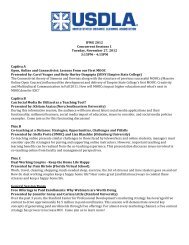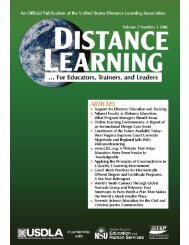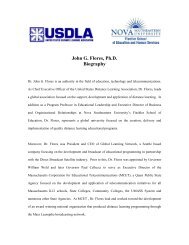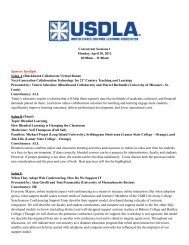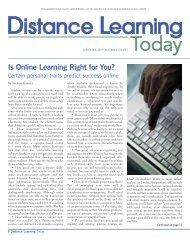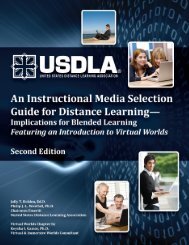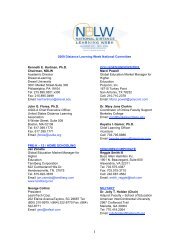United States Distance Learning Association
United States Distance Learning Association
United States Distance Learning Association
- No tags were found...
Create successful ePaper yourself
Turn your PDF publications into a flip-book with our unique Google optimized e-Paper software.
tion. Both classes had a 100% completion<br />
rate. Two students failed the course. However,<br />
this was not unexpected, and we had<br />
actually been prepared for a higher rate of<br />
failure. During the 2007-2008 school year,<br />
six online courses will be offered during<br />
the school day for college credit. Approximately<br />
36 students will participate in these<br />
courses.<br />
The afterschool program, specifically<br />
designed to meet the objective of providing<br />
courses for students not available at<br />
school, offered its first pilot course in February<br />
of 2006. A C++ programming<br />
course was taken by five students. This<br />
program also had a 100% completion rate,<br />
with two of the students going on to take a<br />
three-credit college programming course<br />
during the 2006-2007 school year. In addition,<br />
six students participated in a Veterinary<br />
Assistant online course during the<br />
2006-2007 school year. All students completed<br />
the course. During the 2007-2008<br />
school year, C++ programming will again<br />
be offered as an afterschool option; it is<br />
estimated that four students will participate<br />
in the class.<br />
REFERENCES<br />
Brown, M. D. (2000). Virtual high schools: Part<br />
1: The voices of experience. Education World.<br />
Retrieved October 10, 2004, from http://<br />
educationworld.com/a_tech/tech052.shtml<br />
Durrington, V., & West, R. (2006). The distance<br />
learning division and systemic change.<br />
TechTrends, 50(2), 16.<br />
Frankola, K. (n.d.). Why online learners drop<br />
out. Workforce Management. Retrieved<br />
November 10, 2006, from http://www<br />
.workforce.com/archive/feature/22/26/<br />
22index_printer.php<br />
Gustafson, K. L., & Branch, R. M. (2002). Survey<br />
of instructional development models (4th<br />
ed.). Syracuse, NY: ERIC.<br />
November, A. (2001). Empowering students with<br />
technology. Arlington Heights, IL: SkyLight.<br />
Oblender, T. (2002). A hybrid course model: One<br />
solution to the high online drop-out rate.<br />
<strong>Learning</strong> & Leading with Technology, 29(6), 42-<br />
46.<br />
Tyler-Smith, K. (2006). Early attrition among<br />
first time eLearners: A review of factors that<br />
contribute to drop-out, withdrawal and noncompletion<br />
rates of adult learners undertaking<br />
e<strong>Learning</strong> programmes. Journal of Online<br />
<strong>Learning</strong> and Teaching. Retrieved November<br />
7, 2006 from http://jolt.merlot.org/Vol2_No2_<br />
TylerSmith.htm<br />
THE IMPACT OF TECHNOLOGY ON EDUCATION THOUGH COMPUTERS, PERIPHERALS, SOFTWARE<br />
APPLICATION, AND THE INTERNET HAS CHANGED THE STRUCTURE OF THE HIGH SCHOOL<br />
CURRICULUM.<br />
Volume 4, Issue 4 <strong>Distance</strong> <strong>Learning</strong> 47



